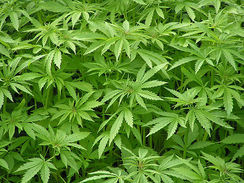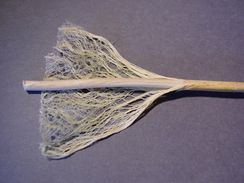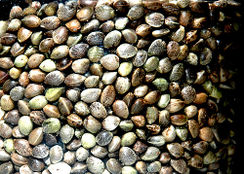Hemp: Difference between revisions
Jump to navigation
Jump to search


m (moved images) |
(added image) |
||
| Line 16: | Line 16: | ||
*a small percentage of hemp was used in what appears to be a [[Biocomposite|composite]] - rather than bioplastic - car body (70% fiber, of which fiber 10% was hemp, and 30% binder) - [http://theangryhistorian.blogspot.com/2010/10/hemp-car-myth-busted.html] | *a small percentage of hemp was used in what appears to be a [[Biocomposite|composite]] - rather than bioplastic - car body (70% fiber, of which fiber 10% was hemp, and 30% binder) - [http://theangryhistorian.blogspot.com/2010/10/hemp-car-myth-busted.html] | ||
*replacement for plastics (example: hemp fiber, [[Biocomposite|biocomposites]], etc.) | *replacement for plastics (example: hemp fiber, [[Biocomposite|biocomposites]], etc.) | ||
* | *Food - The seeds are extremely nutritious. | ||
*animal feed | *animal feed | ||
*body care (soaps - from hemp oil and [[lye]]) | *body care (soaps - from hemp oil and [[lye]]) | ||
| Line 26: | Line 26: | ||
File:Hempstem.jpg|The fiber can be clearly seen here. It is found between the skin and the wood of the stem. | File:Hempstem.jpg|The fiber can be clearly seen here. It is found between the skin and the wood of the stem. | ||
File:hemp1.jpg|Hemp rope | File:hemp1.jpg|Hemp rope | ||
File:HempSeeds.jpg|Hemp Seeds | |||
</gallery></div> | </gallery></div> | ||
Revision as of 19:59, 31 August 2016

Hempcrete: (A) brick, (B) brick with text "Made from hemp hurds, lime and water. As it cures it draws carbon dioxide from the atmosphere, and petrifies the cellulose into stone. Within 50 years it is solid as a rock. This building technique is at least 2000 years old." (C) Construction blocks made from hempcrete (in France). (D) Hemp interior thermal insulation blocks. (E) Hemp lime building under construction in Northern Ireland. External wall after removing the temporary shuttering.

Close-up of hempcrete wall. "The one-storey building uses a prefabricated modular system and a biomaterial called Hempcrete made up of hemp core, lime binders and water. Both features are new to Singapore. Hempcrete is ideal for humid climates as it produces good indoor air quality. It is also very durable, and resistant to pests, mould, mildew and fire."
Hemp has a variety of uses, not just for rope and fabric, but also as a readily renewable resource for making paper, construction materials, high protein food, and safe, clean fuel.
Uses
Hemp can be grown nearly anywhere. It grows very rapidly and has many uses:
- Rope. Hemp fiber is very strong.
- Textiles. Hemp fiber can be woven into a material like light cotton (suitable for T-shirts etc.) or a thick canvas material suitable for bags, warm blankets. See the page on spinning and weaving for instructions on what to do with it once harvested.
- Hempcrete (also see Wikipedia page: hempcrete)
- paper
- a small percentage of hemp was used in what appears to be a composite - rather than bioplastic - car body (70% fiber, of which fiber 10% was hemp, and 30% binder) - [1]
- replacement for plastics (example: hemp fiber, biocomposites, etc.)
- Food - The seeds are extremely nutritious.
- animal feed
- body care (soaps - from hemp oil and lye)
- various chemicals
- fuels (hemp oil / biodiesel/ cellulosic ethanol)
Links
- Overview publication - [2]
- North American Industrial Hemp Council
- Appropedia: Hemp
- OMAFRA: Growing Industrial Hemp in Ontario
Industry Standards
- Largest hemp processing plant in America - [3]




